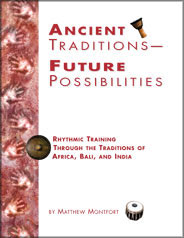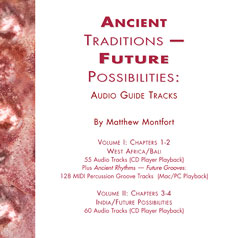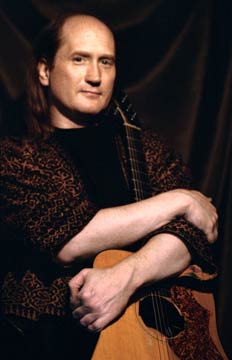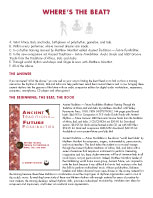Where's the Beat? From Ancient Rhythms to Future Grooves for Gizmos, Gadgets and Thingamajigs
Where's the Beat?
A. West Africa, Bali, and India, birthplaces of polyrhythm, gamelan, and tala.
B. Within every performer, where musical dreams are made.
C. In a rhythm training manual by Matthew Montfort called Ancient Traditions – Future Possibilities.
D. In the new companion set from Ancient Traditions – Future Possibilities: Audio Guide and MIDI Groove Tracks from the Traditions of Africa, Bali, and India.
E. Through world rhythm workshops and Skype study with Matthew Montfort.
F. All of the above.
The Answer
If you answered "all of the above," you are well on your way to finding the beat! Read on to find out how a training manual on the rhythms of Africa, Bali and India can help performers of all types reach their musical dreams, enable listeners to get more out of music, and is now bringing these ancient rhythms into the grooves of the future with the release of an audio companion edition for digital audio workstations, sequencers, computers, tablets, smartphones, CD players and other gizmos!
The Beginning, the Beat, the Book

Ancient Traditions – Future Possibilities: Rhythmic Training Through the Traditions of Africa, Bali and India. By Matthew Montfort. Mill Valley: Panoramic Press, 1985. ISBN 0-937879-00-2. Comb Bound Book- $46.95 list. Book and Enhanced Audio CD Set with MIDI files- $74.95 list. New Best Buy! Book & Audio Guide/MIDI Download- $69.95 list.
This classic "world beat bible" by Matthew Montfort takes the student on a musical voyage through the ancient rhythmic traditions of Africa, Bali, and India with a series of exercises that require no instruments to perform. Interesting, imaginative and fun, these rhythm exercises will be of immense help to all music lovers, not just percussionists. Indeed, Matthew Montfort, leader of the trailblazing world fusion music group Ancient Future, was inspired to write the book because it was difficult for him to find musicians who had the skills to perform multi-cultural music. African polyrhythms, Balinese kotèkan and Indian classical music were chosen as the source material for the training because these three traditions in combination cover the major types of rhythmic organization used in most of the world's music. By enabling home study of these non-Western rhythms with enough material for years of practice for most students, the training develops refined rhythmic skills, promotes multi-cultural musicianship, stimulates new ideas for composers and improvisers, and fosters cross-cultural music appreciation.
The New Guides and Grooves

Ancient Traditions – Future Possibilities: Audio Guide and MIDI Groove Tracks from the Traditions of Africa, Bali, and India. By Matthew Montfort. Ancient Future Music (AF-0001, 2005. V 4.0, 2017). New Preview Release! Companion MP3/MIDI Guide Tracks Download Set- $34.95 list. Companion Audio/MIDI Guide Tracks 2 Volume CD/CD-ROM Set- $39.95 list.
A new downloadable companion set of MP3 audio guide and MIDI groove tracks of the exercises in the book Ancient Traditions – Future Possibilities will be released in fall 2017. The preview beta release is on sale now at Ancient-Future.Com. The downloads are set up for playback on Mac and PC computers, tablets, and smartphones. The tracks are also available on a CD/CD-ROM set.
West African drum music, Balinese gamelan, and Indian tala are oral traditions, and the new downloadable files make it very convenient to integrate the tradition of learning by ear into the rhythm studies. The material is presented in two complimentary formats: audio guide tracks and MIDI groove tracks, which are also available separately as downloads.
The Audio Guide Tracks
Ancient Traditions – Future Possibilities: Audio Guide Tracks is a set of 115 audio guide tracks of the exercises in Ancient Traditions – Future Possibilities that help facilitate correct practice habits. The download version is divided into three zipped folders of MP3 files. Volume I covers the exercises in Chapter 1, West Africa, and Chapter 2, Bali. Volume II A covers the South Indian exercises in Chapter 3, India. Volume II B covers the North Indian exercises in Chapter 3, India, and Chapter 4, Future Possibilities. Two printable .pdf booklets are included: the A.T.F.P Audio Guide Tracks CD Booklet, a wrap around CD booklet with instructions for burning CDs if desired, and the A.T.F.P Audio Guide Track List, which includes the names, durations, tempo settings, and book page numbers for all 115 audio guide tracks.
The MIDI Groove Tracks
Ancient Rhythms – Future Grooves: MIDI Percussion Groove Tracks from the Traditions of Africa, Bali, and India is a complete set of 128 MIDI tracks that playback in Standard MIDI File compatible web browsers. For greater control or for use as rhythm tracks in audio productions, load them into a MIDI sequencer app (Mac, PC, iOS, Android, etc.) to loop tracks, change the tempo, or listen to individual parts. The files come arranged for General MIDI percussion and can be remapped to other instruments using the included MIDI maps with explanations of the sounds of West African drums, Balinese gamelan, South Indian mridangam, and North Indian tabla. A full set of tabla samples is included along with supporting files for using them with VSTi instruments (PC) and GarageBand (Mac).
The Eve Orchestra of West Africa
The Eve people of the island town of Anyako off the coast of Southeastern Ghana have developed a music rich in polyrhythmic interplay, such as in the drum music of takada, a dance and drumming club developed by the Eve women. The instruments of their percussion orchestra are detailed in the West African section of Ancient Rhythms – Future Grooves. The exercises are arranged for General MIDI agogo, bongo, conga and maracas. MIDI maps of the Eve instruments are included for those who want to experiment with different drum sounds.
The Interlocking Rhythms of Balinese Gamelan
A gamelan is an ensemble normally composed primarily of percussion. In Bali, orchestras of tuned gongs, bronze kettles, bronze metallophones, bamboo xylophones, drums, cymbals, and flutes fill the night air with animated music. Melodic parts interlock, divided in such a way that musicians play alternate notes to form the melody line. These interlocking parts, known as kotèkan, require cooperation and a keen sense of rhythm to perform. The Balinese section of Ancient Rhythms – Future Grooves details the music and instruments of the Gamelan Semar Pegulingan and other ensembles.
The Rhythmic Cycles of India
The perception of the cyclic nature of life is reflected in Indian classical music through the device oftala,a recurring time-measure or rhythmic cycle. There are two different traditions in Indian classical music, the Carnatic music of South India and the Hindustani music of North India.
The tabla is a North Indian drum set comprised of two drums with goat-skin heads. For every sound on the drum there is a corresponding syllable. These syllables are known as bols. Each North Indian tala has a theka, a standard set of bols that identify the rhythmic cycle. The MIDI files of these thekas are arranged for General MIDI conga and bongo, and make excellent groove tracks for creating compositions or practicing. The North Indian section of Ancient Rhythms – Future Grooves features a full explanation of the tabla bols complete with audio links to tabla samples of each bol, and files for VSTi instruments and GarageBand that remap the MIDI files to the included tabla samples.
The mridangam is a South Indian two-headed barrel drum made of jackwood with goatskin heads. South Indian drumming has a language all of its own known as solkattu. For the sounds produced by the mridangam, there are corresponding syllables known as konokol. The South Indian section of Ancient Rhythms – Future Grooves features an explanation of the konokol syllables used in the solkattu compositions that are presented. The South Indian rhythm exercises have been arranged for General MIDI conga and bongo. Instructions and sequencer files are included to help in remapping the MIDI files to tabla or mridangam samples.
The Author

Scalloped fretboard guitar pioneer Matthew Montfort has devoted his life to cross-cultural music through his role as the leader of the world music group Ancient Future. He spent years of study with some of the world's best musicians, such as gamelan director K.R.T. Wasitodipuro, North Indian sarod master Ali Akbar Khan, and vina master K.S. Subramanian, with whom he did an intensive study of South Indian note-bending techniques. He has recorded with legendary world music figures ranging from Bolivian panpipe master Gonzalo Vargas to tabla maestros Swapan Chaudhuri and Zakir Hussain, and performed concerts worldwide, from the Festival Internacional de la Guitarra on the golden coast of Spain to the Festival of India in Mumbai. He has taught masterclasses at prestigious universities, schools, camps, museums, and resorts, and has over four decades of teaching experience, including two on the faculty of Blue Bear School of Music in San Francisco. He is recognized as one of the world's 100 Greatest Acoustic Guitarists by DigitalDreamDoor.com, a curated "best of" site, along with such luminaries as Michael Hedges, Leo Kottke, Merle Travis, John Renbourn, Tommy Emmanuel, and Alex De Grassi. He was interviewed in the December 2009 Les Paul issue of Guitar Player Magazine about the scalloped fretboard guitar and the application of the rules of Indian raga to the music of Jimi Hendrix as exemplified by "Purple Raga" from his debut solo recording, Seven Serenades for Scalloped Fretboard Guitar.
The Workshops and Skype Lessons
Matthew Montfort offers instruction based on Ancient Traditions – Future Possibilities through online lessons via Skype and rhythm workshops at conservatories, public schools, and resorts.
The Quotes
"You can view this deceptively slim masterwork from a few different angles: as a friendly yet serious appetizer on three of the most sophisticated rhythm systems on earth; a chance to work on your rhythmic sight reading; a three-culture dip with matching mp3s for your ears; a gateway to exotic spices, complete with MIDI files, for your songwriting or drumming; or a fun way to organically digest complex time signatures. No matter how you slice it, this scholarly labor of love is packed with rich flavors for those patient enough to harvest them." – E.E. Bradman, Bass Player Magazine
"You've heard Afro-Pop, sitar, gamelan and world music for years. But do you know what they are and how they work? Better yet, would you like to play those twisted cross-rhythms and melodies? In Ancient Traditions – Future Possibilities, Matthew Montfort, a founding member of the world music band Ancient Future, has put together the book for people who want to dig into world music with both hands. The first section of the book covers traditional music of West Africa, Bali and India with theories and exercises. Wherever possible, Montfort has provided beat counts alongside the standard musical notation so even if you can't read music, you can still learn the rhythms. The last section of the book mixes patterns from different cultures, demonstrating the powerful music these simple exercises can generate." – Richard Kadrey, San Francisco Chronicle
"A hands-on exploration of Balinese, African, and Indian rhythms that should appeal to all musicians. One needn't play percussion instruments, or any instruments at all, for that matter, to use and benefit from the book." – Drums and Drumming
"A very practical manual. There is enough material to keep interested musicians busy for years. Montfort has done a great service for western musicians interested in world music. A pleasure to work with." – Option
"Very highly recommended for any instrumentalists hoping to expand their rhythmic horizons. If you've never investigated the beautiful clash of African polyrhythm, the incredible interlocking textures of Balinese music, or the complex metric structure of Indian classical music, check out Ancient Traditions – it will blow your mind and deepen your groove." – Guitar Player
"If you're tired of programming your drum machine with the same old 4/4 back-beat, or you want to sharpen your rhythmic chops, this book is highly recommended." – Electronic Musician
"An excellent book for use in percussion technique sessions or other classroom situations. The descriptive material is lucidly written and is aimed at a novice." – Percussive Notes
"Not just a book about world music, but a guide book on how to create it. Sections include styles of Northern and Southern India, West Africa and Balinese gamelan. In the 'Future Possibilities' section, you see how to combine styles into something new, weird and beautiful." – Covert Culture Sourcebook
"Offers a series of enjoyable exercises based on authentic rhythms and mnemonic found in the featured cultures. Appropriate for grade 3+ though adult expert, all can be performed using hands, voice, body or desks, cans, etc. or traditional instruments." – World Music at West Music
The Performers
Ancient Traditions – Future Possibilities has been used and admired by many teachers and musicians around the world.
Lou Harrison (1917-2003), prominent composer and founder of the American gamelan movement, called the work "a very useful contribution to musical scholarship."
Reinhard Flatischler, founder of the TaKeTiNa rhythm training process, was an early enthusiast of the method book.
John Bergamo (1940-2013), composer and coordinator of the percussion department at the California Institute of the Arts, found a copy of Ancient Traditions – Future Possibilities when he cleaned out his desk at retirement. As he finally had the time available, he worked his way through it, after which he called the author to thank him for writing it, and encouraged him to write more world music training manuals. One is in the works.
Steve Smith, stellar jazz and rock drummer of Journey fame, went through the book in preparation for a percussion summit with tabla master Zakir Hussain.
Start your own journey to musical excellence with Ancient Traditions – Future Possibilities!
The Promotion
Review and exam copies of the Ancient Traditions – Future Possibilities: Audio Guide and MIDI Groove Tracks are available as downloads to media outlets and music schools. Send requests to info@ancient-future.com.
The promotion campaign includes rhythm workshops at conservatories, public schools, and resorts; videos at www.youtube.com/ancientfuture; interviews and reviews in major newspapers, magazines, web sites, and on radio; and free introductory rhythm lessons online at Ancient-Future.Com, a high traffic world music education site.
The Retail and Wholesale Outlets
Available online at www.ancient-future.com, and wholesale to retail outlets and music schools from:
Ancient-Future.Com Books and Records, P.O. Box 264, Kentfield CA 94914-0264.
Email: info@ancient-future.com. Tel: 415-459-1892.


